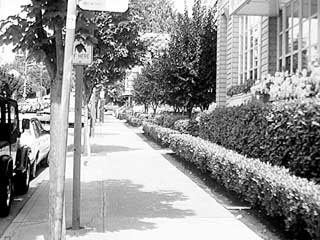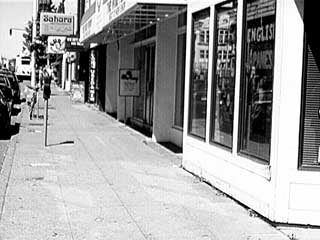
Surveys
DJC.COM
July 12, 2001
Tree investment brings cities many happy returns
University of Washington

Trees and shrubs help create a more friendly environment. |

Without vegetation, sidewalks can be cold and uninviting. |
If you ask a friend to visualize a city where they would like to work or live, trees and green spaces will likely be central to the mental image they share. Trees and green spaces are often the most common outdoor indicator of livable and sustainable communities!
The beauty of trees is appreciated by nearly everyone, and urban forests provide much more than just aesthetics. Yet, here in our region, perhaps because we take trees for granted, much of the urban forest is stressed. A 1998 study by American Forests revealed a multi-decade trend of forest loss in Seattle.
Forest canopy is one measure of health of an urban forest. City-wide loss of high density tree canopy from 1972-1996 was 48 percent; loss of medium density canopy in the same time period was 67 percent. City-wide canopy cover in Seattle is now about 25 percent. Residential areas average about 16 percent, far below a American Forests standard of 40 percent).

Wolf |
There are serious challenges to the sustainability of Seattle’s urban forest. Many of Seattle’s parks contain remnant stands of native forest. Heavy infestations of invasive plants — ivy, blackberries, Scot’s broom, etc. — threaten this natural legacy. And the 19-year pruning cycle for Seattle’s street trees is well above the 9.9-year average for comparable American cities.
Because the city of Seattle does not have an up-to-date inventory of its street and park trees, it is difficult to estimate and monitor tree data, track work records and costs, or assess management needs.
30,000 new trees planted since 1999
There are some positive trends, however. The rate of tree planting has increased significantly; since 1999, the city has planted more than 30,000 new trees. The ProPark levy funded an additional tree crew for city parks that was desperately needed (even while Initiative 695 cut funding for one of the street tree crews.) Also, City Light and Seattle Transportation have implemented a kinder, gentler approach to trees when installing new fiber optic cable.
Why should the business community, employers, the city and residents care about the trees in Seattle? Why should governments and business people make the commitment to include trees in future development?
Trees provide many indirect benefits. Greenscapes provide energy savings, improve air quality, assist with surface water management and provide visual and noise buffers. Social scientists have learned that having nature nearby helps people cope with stress and anxiety and benefits child development. Scientists have studied the role of trees in human communities to better understand environmental and social benefits. Many of these benefits translate to economic benefits -dollars saved!
For example, in a heavily forested landscapes of western Washington, complete with shrub layers and ground cover, 74 percent of rainfall is released back to the atmosphere or is absorbed into the ground. In the typical urbanized landscape 40 percent of rainfall is naturally processed (data from Center for Urban Water Resources Management, University of Washington) thus an additional 34 percent of the rainfall becomes surface runoff and must be directed into engineered structures. Having an urban forest, balanced with built elements in cities, can reduce infrastructure costs as stormwater management systems can be downsized.
Trees also are associated with higher property values. Several studies around the country have analyzed the relationship of forests and sales prices of residential properties. A 6 percent increase in value was found in one study; 3.5-4.5 percent in another. Across an entire community or city, these small boosts add up to significantly higher tax revenues.
Business recruitment and relocation efforts can benefit from green spaces. Businesses are often more willing to locate in places where the promise of a satisfying lifestyle can be used to attract and retain employees. Trees in the landscape of office buildings, home sites and commercial districts create places that are more livable and appealing.
The psychology of trees
Streetscape improvements are a key strategy in revitalizing business districts. In research conducted by the University of Washington, consumers were asked to compare their shopping behaviors in places that had no vegetation with business districts having an urban forest. Consumers’ perceptions were more favorable for districts with trees, including interpretations of the quality of products and level of customer service. People also reported being likely to visit a business district with trees more often and staying longer after arriving. Finally, people were asked to report their willingness to pay for products; consumers were willing to pay an average of 12 percent more for goods in a landscaped district.
The collective appearance and quality of a place, including its urban forest, send cues about the experience of place that one would expect. A healthy, well-maintained community landscape tells visitors and prospective businesses about the pride and values of a community.
While we think of trees contributing to the ambience of a neighborhood, community or entire city, trees also have a significant impact on individual people. Environmental psychologists are learning that working and living near quality green spaces can satisfy deeply felt psychological and physiological needs for many people. Having a view of nature from one’s office window has been shown to increase employee job satisfaction and reduce feelings of job pressure. Employees with nature views also reported 23 percent fewer health ailments, a probable influence on absenteeism. The commuting experience influences a person’s mood and ability to concentrate long after she leaves the car; research indicates that the presence of trees in the roadside reduces traffic stress response.
The benefits of an urban forest are possible only if planned and managed comprehensively and as a ‘green infrastructure’. Citywide systems of roads and utilities deliver services in a comprehensive and predictable manner. Likewise, systems of trees, forests and green space should be planned to provide plant and ecosystem benefits throughout a community.
For instance, while the rate of tree planting has increased in Seattle in response to canopy losses, the result is a collection of young and small trees lining the city streets; 49 percent of street trees are 5 inches in diameter or smaller and only 14 percent are 12 inches or larger. But the environmental, economic and social benefits of trees increase dramatically as they age. Comprehensive, routine management is needed to insure that trees mature into a vital, healthy forest and are also compatible with adjacent land uses. Quality management is dependent on private and public sector partnerships.
The Puget Sound region has historically had strong economic ties to its trees and forests. Today, the regional economy has diversified but trees are no less important. Local economies - including technology, tourism and international trade - are dependent on quality of place. Quality places attract companies, customers and the best employees. Investment in the urban forest is essential to create and sustain the habitat of commerce.
Kathleen L. Wolf, Ph.D., is a faculty member at the University of Washington’s College of Forest Resources. For information, contact her at (206) 616-5758 or kwolf@u.washing-ton.edu.
Other Stories:
- Pesticide-free parks teach new lessons
- Construction faces new foe: toxic mold
- Water metering: the debate trickles on
- Studies sniff out Tacoma smelter plume
- From wood preservation to site remediation — the Cascade Pole cleanup
- New rules for birds, bogs and bulldozers
- Isolated wetlands ruling creates confusion
- Environmental metamorphosis on the Duwamish
- Mitigation banks balance habitat, development
- New Pin Foundation minimizes site impacts
- Bringing a city stream back to life
- Knitting a trail of green
- Stormwater problems? Put a LID on it
- More brownfield incentives in the pipeline
- SEPA document trends since GMA and regulatory reform
- Helping environmental groups to get wired
- Shedding light into the permit ‘black hole’
- Frequently asked ESA questions
- Muddy waters: The new 4(d) salmon rule
- Global climate change starts at home
- At EPA, next 4 years won’t be boring
- Dams vs. fish? Mediate it!
- 'House calls' help firms to conserve
- Building a greener future on Bainbridge
- Power users, producers turn toward the sun
- Seattle goes climate neutral
- Bamboo’s popularity shoots up
- Tiny town recycles Goliath proportions
- MTCA revisions take effect Aug. 15
- Environmental education: Knowing what’s in your backyard
- Bear Creek roars again
- UW Bothell — a wetland lesson in the making
Copyright ©2009 Seattle Daily Journal and DJC.COM.
Comments? Questions? Contact us.